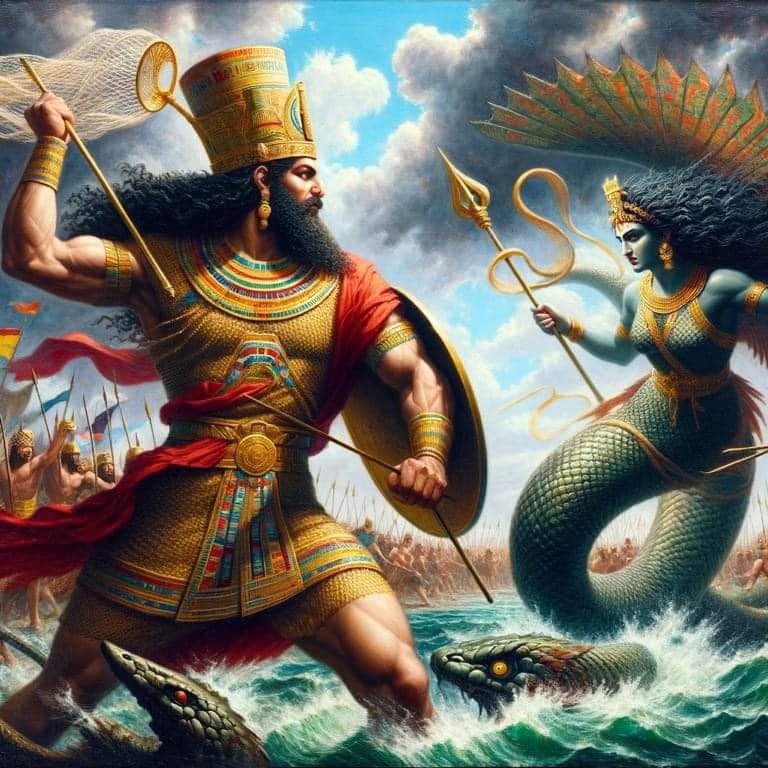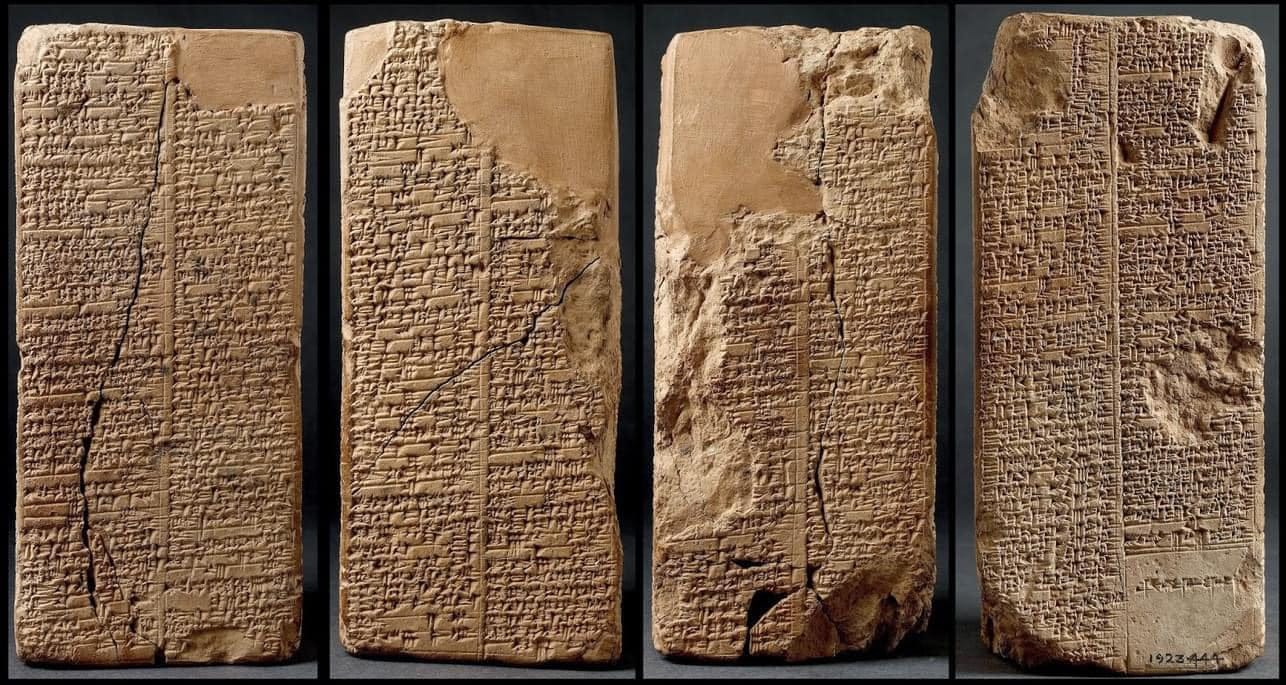Wait... the Genesis Story of Creation is not Unique?
The Babylonian Creation Narrative versus The Story of Creation in Genesis
This article has been narrated by Brian Spicer (Author) and is a great way to hear this incredible story of two Epics duking it out. Just click play, you can either follow along on the screen or close your phone and listen. Either way, please enjoy
Parallels Between the Narratives
Since the discovery concerning thousands of clay tablets within the library of King Ashurbanipal (668-627 B.C.) in the ancient city of Nineveh, every skeptic and Christian has heard of the comparison between the Babylonian Creation Myth and the Hebrew Bible’s Genesis Creation Narrative. Initially there appears to be a lot of similarities to these ancient Near Eastern mythological and ontological depictions for the start of the universe. Here are some of the simple correlations made between the two narratives:
Matter existed prior to creation beginning
Darkness precedes the creative acts
The goddess Tiamut personifies the sea and represents the abyss, similar to the “deep” (Hebrew word for tehom, which linguistically is related to the word Tiamut)
Light exists before sun, moon, and stars
There is a division depicted between the heavens and the earth, also known as “the firmament”
Sequence of creation is similar (i.e. division of water, next dry land, then luminaries, and lastly humanity)
While at a surface level, there are parallels that can be made between these two ancient texts. This does not require the conclusion that they are directly related. Rather that the similarities displayed teach a modern reader how groups thousands of years ago understood, collectively, humanity’s beginning. Here is an illustration to better comprehend the historical perception.
Moby Dick Analogy
Imagine if there were two separate groups that were instructed to study the first chapter of Moby Dick and write down their findings. One group may consist of individuals that are naturally more artistic and imaginative, while in contrast, the other group is made up of academically and cerebrally minded people. The former group of imaginers creates notations on the how the imagery is so encapsulating there is nothing more defining than the use of comparison through the medium of picturization. The latter group of analytical minds discover great quotes from characters that are alluding to an outside resource that clearly is indicative of their personal belief system. Consequently, while both groups started with the same material, in a broad sense, they would come to similar conclusions about how the Moby Dick is a wonderful work of literature and incites deep meaning. This is due to the fact that both groups were looking at the same beginnings to differ knowledge. Although they perceived different focal points of the textual narrative, their conclusions would have similarities in regards to the broader concept of meaning distilled out of their source material. This is exactly how to comprehend the Babylonian’s and Israeli narratives.
Pete Enns who writes for the BioLogos publication said this about how to compare the texts
“The biblical descriptions of creation and the flood are ancient texts that address ancient issues within the scope of ancient ways of knowing. These stories are not to be read as if overlapping with or informing scientific investigation of human origins or modern notions of historiography. To think that they do is a genre misidentification of a most fundamental order.”
When comparing these two ancient Near Eastern creation narratives, according to Mr. Enns, rather than understanding the Babylonian version (Enuma Elish) as having directly inspired the Genesis’ story of creation; readers can infer how to better internalize the stories and their intended purposes. Knowing and understanding the genre of a text gives context to the reader for how to interpret the authors takeaways. If there was a student that was determined to discover interstellar travel. During the planning phase decided to use Star Trek as their cornerstone for analytical analysis. Egregiously mistaken would be the only way to describe the error in their genre identification capabilities.
Genre Category for Genesis Narrative
Jewish and Christian tradition teaches that the original author of the first five books of the Bible (Torah/Pentateuch) was Moses, son of Amram. Whether the books were written directly by Moses or a collection of authors from the primitive Israelites does not change the purpose of the writings, or for that matter, their authority. Within the first three chapters of Genesis, the intention is clearly to teach the newly freed slaves of Egypt that the god’s they have seen throughout culture and society are not the true God of the Universe. Ancient cultures and civilizations would have had stories of creation and Moses needed to instruct his people of who their God was. Elohim was the only God of the universe.
The genre of Genesis chapter 1 is Cosmogony. Rooted in the Greek word ‘kosmos (cosmos)’ meaning: order of world. Then combined with the Greek suffix ‘gonia (-gony)’ meaning: begetting (derived from). Therefore cosmogony refers to the origin and development of the universe. Knowing that the Biblical narrative is not written in the same genre as a science textbook sets the back drop for how to understand the text’s meaning better.
Babylonian Creation Myth (Enuma Elish)
Nearly 100 years ago Mr. George Smith, one of the pioneers of Assyriology, helped discovered the tablets specific to Enuma Elish. Just like how there are 7 days for creation in Genesis 1, there are 7 tablets depicting a poem of creation. Written in honor of the Babylonian god Bel-Merodach, who had usurped other gods higher than he in a cosmological paradigm. The early Babylonians declared Merodach as the creator of the world since he absorbed all the higher tier gods powers and their positions.
This work describes an epic of creation established within a poem’s intent to celebrate a god’s supremacy. As a narrative, Enuma Elish was written by the Babylonian’s to display the evolution for order out of chaos and light out of darkness. In contrast to Genesis, this evolution was a struggle. Primordial forces fighting to overcome one another. One side was Merodach’s and the other The Dragon of Chaos. Personifying the deep, the abyss of water that unless restrained would swallow up the whole world. The defeat of this dragon was not the first attempt on its life, rather many gods had tried and failed.
In the Deep, the Babylonians saw the prior to all things. The origin to all origins. A belief so ingrained into their societal mind that its involvement in stories of creation was required to presuppose it. This belief was developed in the seaport of a primitive Babylonia, some 7-8 thousand years ago. Natives saw the land growing out of the sea and created the doctrine that all things must have come from the Deep.
After defeating the Dragon of Chaos, Merodach took the Deep and created everything anew. In this creation came light, the sun and stars, Earth and its inhabitants.
Comparing the Two
In this brief overview of Enuma Elish, there are differences that can be appreciated by scholars. Most distinctly is that the God of the Bible does not have to struggle against other forces to gain dominion. There is also not a lengthy overly dramatized plot spanning 900 lines compared to Genesis’ modest 31 verses.
These two texts ‘breath the same air’, but they are not on the same altitude. Genesis 1 as a creation narrative and cosmogony, is completely unique to Israelite Theology. Enuma Elish is a great tool to calibrate the genre of literature for Genesis, but does not diminish its inherent priceless quality.
Genesis (G) starts with God establishing reality
Enuma Elish (E) has pantheon that came into being
G displays God’s Omnipotence and Sovereignty
E lacks a proper strength tier list until Merodach (M) finally overcomes the Dragon/Deep
G has light prior to physical sources that represent God’s Holiness and also Jesus/Holy Spirit (derived from original Hebrew text)
E has no logical representation or meaning for light prior to sources
G showcases a personal God that cares so much that He creates for His creation. Giving life not for internal gain, but out of love
E illustrates M desperately desiring worship and praise, so he creates man to worship him in temples to give himself more power
Conclusions
While the Israelite Nation was not created in a vacuum and would initially and inevitably be influenced by the surrounding cultures and societies, that does not presume its fallibility. Superior inference, hermeneutics of texts and their interpretation can be derived from what Cohn-Sherbok instructs in his book Judaism: History, Belief and Practice
“The Canaanite religious structure as well as the earlier Sumerian and Akkadian religions set the backdrop for the emergence of the religion of the ancient Israelites. The earliest stories in the Torah (Genesis, Exodus, Leviticus, Numbers and Deuteronomy) contain centuries-old legends, composed in the light of Mesopotamian myths.” (pg. 6, Cohn-Sherbok)
Clearly a finer tool kit to understand these texts uses the information that legends existed at the time of composition, but only used in illustration to the Israelites how Elohim’s creation narrative was opposed to the Enuma Elish.
Works Cited
Genesis 1 and a babylonian creation story. BioLogos. (2023a, September 28). https://biologos.org/articles/genesis-1-and-a-babylonian-creation-story
The genre of Genesis 1 is “cosmogony.” BioLogos. (2023c, September 29). https://biologos.org/articles/the-genre-of-genesis-1-is-cosmogony
Mesopotamian myths and “genre calibration.” BioLogos. (2023b, September 28). https://biologos.org/articles/mesopotamian-myths-and-genre-calibration
Sayce, A. H. (n.d.). THE BABYLONIAN AND BIBLICAL ACCOUNTS OF THE CREATION. Journals Chicago. https://www.journals.uchicago.edu/doi/pdf/10.1086/478500
THE AMERICAN JOURNAL OF THEOLOGY Volume IX 1/1905






Wow! Well done!